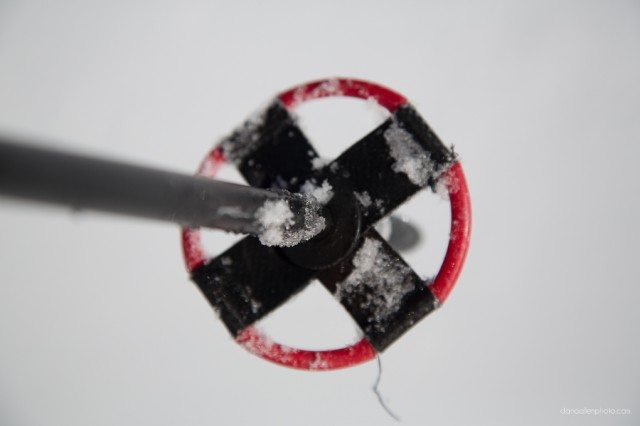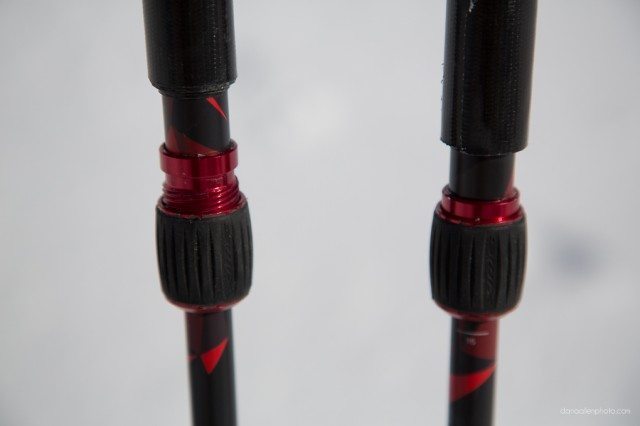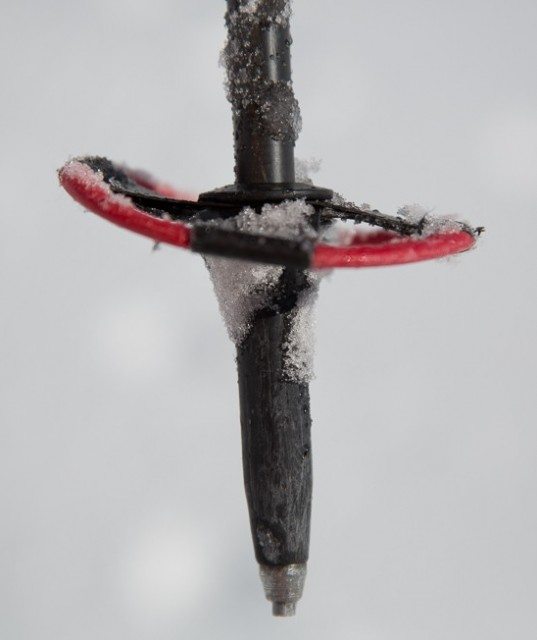
Swix Sonic R1 Adjustable Carbon Ski Poles
Size Tested: 115-140cm
Sizes Available: 105-130cm, 115-140cm, 125-150cm
Weight: 219 grams (per pole)
MSRP: $249
Features
- EVA foam grip
- One-hand adjustable strap
- Hypalon strap and loop basket
- Aluminum twist lock for adjustability
- All-carbon tubes
Reviewer Info: 5’10”, 185 lbs.
Test Locations: New Zealand, Vermont
Days Tested: ~17
[Editor’s Note: We’ve updated this review after spending several weeks testing the production version of this pole. Ultimately, we found that Swix has made some important improvements to the twist-lock adjustment system—see the update below for more information.]
The Swix Sonic R1 is a new venture for the Norwegian company. Known primarily for their cross-country-oriented gear, Swix decided to enter the backcountry touring market by introducing an adjustable alpine pole.
Weight
The Sonic R1 is definitely light weight. I’ve been using two different ski poles for the past few years: the Scott Team pole (aluminum, 120cm fixed length) and a 4-year-old Black Diamond Carbon Traverse pole for backcountry touring (115-140cm adjustable). Not only is the Sonic R1 lighter than these poles, it’s also stiffer. (More on that in a bit.)
Grip / Strap
The Sonic’s grip and strap are comfortable. The grip is made of soft EVA foam glued to a molded plastic piece on the shaft. The softness of the grip and the light texture of the foam makes it easy to hold and the strap is easy to adjust thanks to its large, semi-rigid pull tab. Other poles I’ve used have had hard, smooth plastic grips, which can be a bit slippery.
Basket
One of this pole’s best features is the retro-style basket with its plastic-coated, heavy gauge wire circular frame. Two pieces of heavy-duty Hypalon (think plastic-coated nylon) make up the cross piece. This design is light, and since it can pivot around the shaft, the flexible basket will conform to the slope’s angle when you’re planting a pole. The basket doesn’t leverage the tip of the pole out of the snow, which can be frustrating—and dangerous—on steep, icy slopes.

Twist-Lock System
Now, on to arguably the most important feature of the Sonic R1. The pole features a twist-lock system to adjust height that’s located 6.5” from the bottom of the grip. Compare that with the FlickLock on the Black Diamond Carbon Traverse, which sits 12.75” below the grip. According to Swix, the higher placement gives you better access to the lock when you want to adjust length, and it lets you use the nut as a grip when you’re skinning up steeper slopes. (Black Diamond now offers grips on their poles for the same reason, but they’re heavier than the Sonic R1.)
Swix claims that they’ve solved the twist-lock problems of the past, namely the poles loosening up over time. Instead of using an internal bushing that expands and presses on the inner walls of the upper shaft, Swix uses an oversized nut that compresses a plastic sleeve around the lower shaft. Having had a pair of Leki twist-lock poles in the past that didn’t work well at all, I was curious to see whether Swix had substantially improved the system.

Skiing Performance
- Swing Weight
As a former tele-skier, I like to use poles that are fairly short for my height. I set the Sonic R1s at 115cm, and left them there for the remainder of the trip.
Since the poles are so light (219 grams / pole), there’s very little pendulum effect when you’re skiing. If you really like a pole that seems to swing forward all by itself, the Sonic likely won’t do that as well as heavier poles like the Black Diamond Carbon Traverse, the Scott Team pole, or the Swix all-carbon Medieval.
- Stiffness
The Sonic feels very stiff when planted. That’s opposed to the Black Diamond Carbon Traverse, which often feels quite flexy. I think this difference is at least partially due to the fact that the Traverse is skinnier than the Sonic R1. Check out the chart below:
I think the Swix R1 is stiffer than the Traverse partly because of its wider tube diameter. Generally stiffness increases with diameter at a cubed rate. So if you double a tube’s diameter, you increase its stiffness by a factor of eight (2^3). Since the R1 is 60 percent larger than the Carbon Traverse, it makes sense that it’s also stiffer. (Wall thickness also plays a role, albeit a lesser one.)
The exact layup and modulus of the carbon fiber could also affect stiffness, but that’s not something I could test for.
Hiking Performance
I haven’t yet used the Sonic R1s for skinning, but I did use them everyday for hiking, which is pretty darn similar.
When I’m hiking, a pole’s swing weight matters less to me, and weight and stiffness matter more. And here, the Sonic excels. The poles are very lightweight, and they feel just as solid when I’m pushing against them to go uphill as they do when I’m pole planting on the down.
I found that the adjustability nut does function as a grip when I’m going up steep sidehills, but since the nut is small, it doesn’t give you a great grip, and I’d recommend putting some grippy tape on the upper shaft if you plan to do a lot of steep traverses.

As I mentioned before, I loved the basket on the Sonic R1. Other poles I’ve used that have rigid plastic baskets make it difficult to stick the pick in the snow when I’m on a steep, icy slope—plant the pole at one angle, walk forward and lean on the pole, and the pick will pop out due to the leverage exerted by the basket. Black Diamond tried to solve this problem with their ¾ basket, but I didn’t find it to work that well. Swix has solved this issue with the flexible, pivoting basket, which also has smooth, round edges so it doesn’t catch on the snow.
I didn’t particularly like the tiny pommel on top of the grip. I like to put my hand on top of the pole while hiking, but the pommel on the Sonic R1 is almost 1/2″ narrower than that on the Carbon Traverse. The Black Diamond pole is also curved to fit your hand, while the Sonic R1 is almost flat on top.
NEXT PAGE: UPDATE —Adjustability


$250 for a set of poles, Yeah right. You can buy a season pass at some resorts for that kind of money.
Nice and light poles which feel really good. Unfortunately, l snapped one in half when telemark skiing this winter at Niseko in Japan. It made me question the strength of the carbon used in these poles. I needed to buy another brand of ski stocks because none of the local ski shops stocked this brand. It seems you definitely pay a price for lightness. But, that said l still like the Swix Sonic poles.
I bought these poles and snapped them after one run. I would steer clear of these. Back to el-cheapo aluminium for me.
I snapped the shaft in two when whacking snow off my skins. Not great on day one of a 3 day tour! Great poles to ski with apart from this durability issue.
I’ve had a pair of the R1 Sonic Carbons for two and a half seasons now. The length adjustment is easy enough to do with gloves on if you want to lose 5cm or so for a bump run or two. They swing and place better than any other pole I’ve owned. I use them mostly inbounds at Alta/Snowbird. I haven’t broken them yet. Reported fragility may indicate some (batch?) fabrication problems, but mine have held up fine. I’ve fallen on them once or twice and tipped them hard onto rocks more than a few times. I saw them at the shop, swung them and others on the rack a few times and liked them a lot. Honestly when I saw the price it made me feel a little precious, but I treated myself to a late Christmas present anyway and I’ve never regretted it on the hill. I figure 100+ days – at about $2/day. I’ve spent more than that on coffee.